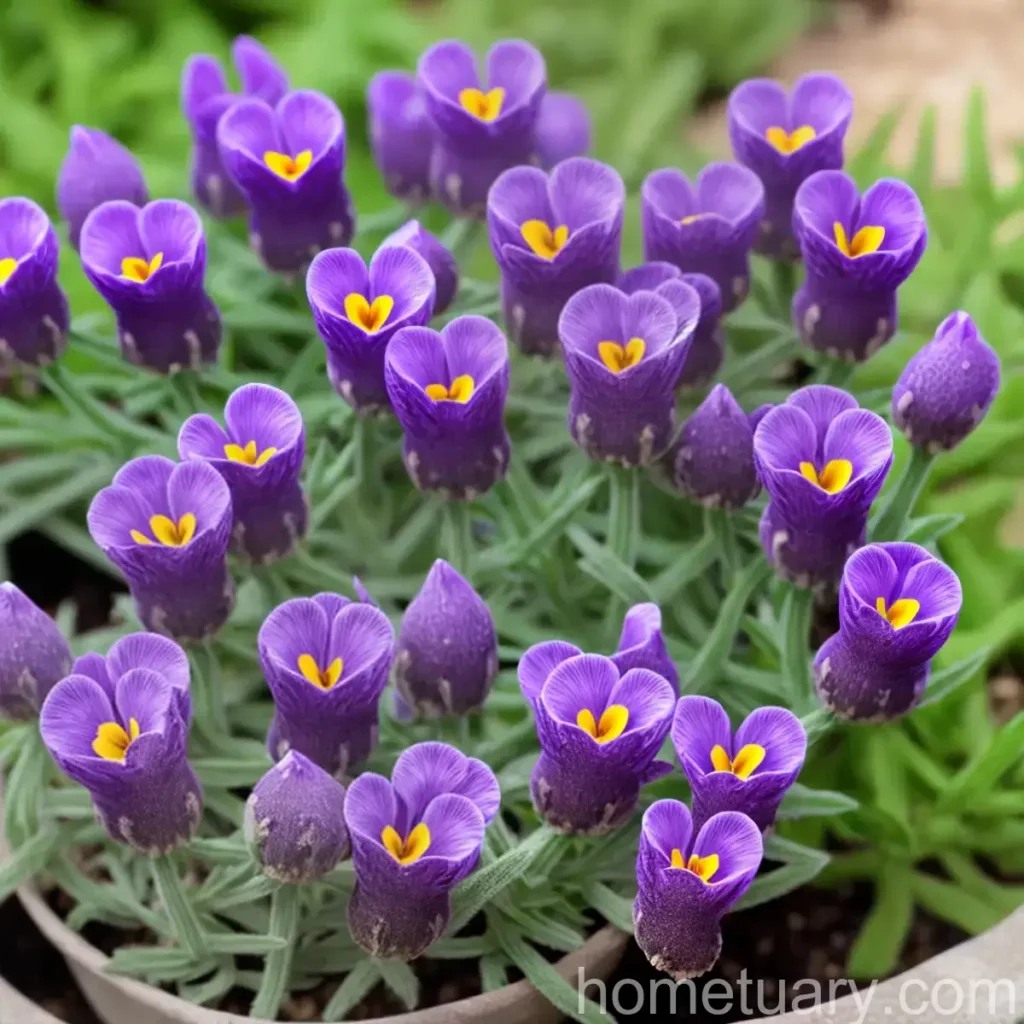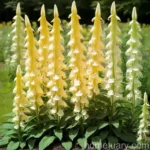Purple-Net Toadflax (Linaria reticulata): A Plant Scientist’s Guide
Plants have been an integral part of human existence for thousands of years. Not only do they provide oxygen and food, but they also contribute to the aesthetic appeal of our surroundings. In this in-depth guide, we will deep dive into the captivating world of the Purple-Net Toadflax (Linaria reticulata). From its cultural significance to care tips, propagation methods, common diseases, and interesting facts, this article aims to provide a comprehensive understanding of this beautiful plant species.
What is the Purple-Net Toadflax (Linaria reticulata)?
The Purple-Net Toadflax, scientifically known as Linaria reticulata, is a charming and delicate perennial plant that belongs to the genus Linaria and the family Plantaginaceae. It is native to the Mediterranean region and is known for its unique purple-netted flowers, which bloom during the spring, adding a touch of elegance to gardens and landscapes.
The plant features slender stems bearing clusters of small, tubular-shaped flowers that are adorned with intricate purple veins, giving rise to its common name, “Purple-Net Toadflax.” This species is renowned for its versatility, making it a popular choice for various landscaping and gardening endeavors.
Key Takeaways – Purple-Net Toadflax (Linaria reticulata)
Before delving into the detailed aspects of the Purple-Net Toadflax, let’s take a quick look at the key takeaways of this captivating plant:
- Scientific Name: Linaria reticulata
- Common Name: Purple-Net Toadflax
- Plant Type: Perennial
- Family: Plantaginaceae
- Native Habitat: Mediterranean region
- Distinctive Feature: Delicate, tubular flowers with purple net-like veins
Now, let’s explore various facets of the Purple-Net Toadflax, including its cultural significance, uses, and essential care requirements.
Culture
Understanding the cultural significance of the Purple-Net Toadflax is essential for appreciating its historical and modern-day relevance. This plant has been a part of various traditions and practices, making it an intriguing subject of study.
Uses
The Purple-Net Toadflax has been appreciated for its diverse uses, encompassing both practical and symbolic applications. Some of its prominent uses include:
- Ornamental Purposes: Its delicate purple-netted flowers make it a sought-after choice for landscaping, adding an enchanting touch to gardens, borders, and rockeries.
- Medicinal Properties: In some traditional practices, the Purple-Net Toadflax is believed to possess medicinal properties, although scientific evidence supporting this claim is limited.
- Floral Arrangements: The attractive flowers of this species make it suitable for creating captivating floral arrangements, enhancing the visual appeal of bouquets and displays.
Water
Proper watering plays a crucial role in ensuring the health and vitality of the Purple-Net Toadflax. Understanding its water requirements is essential for maintaining optimal growing conditions.
Water Requirements
-
Moderate Moisture: The Purple-Net Toadflax thrives in well-drained soil with moderate moisture levels. Overwatering should be avoided, as it can lead to root rot and other detrimental conditions.
-
Established Plants: Once established, this species exhibits moderate drought tolerance, making it suitable for regions with sporadic rainfall or dry spells.
-
Watering Frequency: During the active growing season, regular and consistent watering is recommended, ensuring that the soil remains evenly moist without becoming waterlogged.
Sunlight
Proper exposure to sunlight is essential for the growth and flowering of the Purple-Net Toadflax. Understanding its sunlight requirements is vital for creating an ideal environment for this plant.
Sunlight Requirements
-
Full Sun: The Purple-Net Toadflax thrives in full sunlight, benefiting from at least 6-8 hours of direct sunlight daily. Insufficient sunlight can lead to leggy growth and diminished flower production.
-
Partial Shade: In regions with intense summer heat, providing partial shade during the hottest part of the day can prevent sunscald and enhance the overall health of the plant.
-
Optimal Orientation: Placing the plant in a south or west-facing location ensures that it receives ample sunlight, promoting robust growth and prolific flowering.
Fertilizer
Proper nutrition is essential for the Purple-Net Toadflax to flourish and produce an abundance of beautiful flowers. Understanding its fertilizer requirements is crucial for providing the necessary nutrients for healthy growth.
Fertilizer Application
-
Balanced Fertilizer: Using a balanced, all-purpose fertilizer in the spring as new growth emerges helps provide the essential nutrients for the plant’s development.
-
Application Frequency: Fertilizing once every 4-6 weeks during the active growing season supports continuous flowering and overall vigor.
-
Careful Application: Applying fertilizer according to the manufacturer’s instructions, and avoiding excessive fertilizer usage, prevents the risk of nutrient imbalances and potential harm to the plant.
Soil
The soil composition and quality profoundly impact the health and performance of the Purple-Net Toadflax. Understanding its soil requirements is essential for creating an optimal growing environment.
Soil Type
-
Well-Drained Soil: This species thrives in well-drained, loamy soil with good fertility, allowing excess water to drain away efficiently and preventing waterlogging.
-
Soil pH: A slightly acidic to neutral soil pH (pH 6.0-7.0) is ideal for the Purple-Net Toadflax, supporting nutrient uptake and overall plant health.
-
Amendment: Incorporating organic matter, such as compost or well-rotted manure, during soil preparation enhances its structure and fertility, providing an excellent growing medium for the plant.
Pruning
Proper pruning practices are essential for maintaining the attractive appearance and health of the Purple-Net Toadflax. Understanding the pruning techniques and timing is crucial for achieving desirable outcomes.
Pruning Techniques
-
Deadheading: Regularly removing spent flowers through deadheading encourages continuous blooming and prevents the plant from diverting energy into seed production.
-
Seasonal Pruning: After the flowering period, performing a light pruning to remove any leggy or unsightly growth promotes a neat and compact habit, enhancing the plant’s aesthetic appeal.
-
Minimal Pruning: As this species tends to maintain a tidy growth habit, minimal pruning beyond deadheading and seasonal tidying is generally required.
Propagation
The propagation of the Purple-Net Toadflax allows for the expansion of its presence in gardens and landscapes. Understanding the various propagation methods is essential for multiplying this beautiful plant.
Propagation Methods
-
Seed Propagation: Growing the Purple-Net Toadflax from seeds offers an effective and economical way of obtaining new plants. Sowing the seeds in early spring provides ample time for establishment and flowering during the same year.
-
Division: Dividing mature clumps of the plant in early spring or fall allows for the creation of new, identical plants, ensuring genetic uniformity and preserving the desired traits of the species.
-
Stem Cuttings: Propagating from stem cuttings, particularly in the late spring or early summer, offers an expedited method of obtaining new plants with identical characteristics to the parent plant.
Container Popularity
The Purple-Net Toadflax exhibits remarkable adaptability to container cultivation, making it a popular choice for various container gardening endeavors. Understanding its cultivation in containers is vital for maximizing its ornamental potential.
Container Cultivation
-
Container Selection: Choose a container that provides adequate drainage and sufficient room for root development, ensuring the plant’s overall health and vitality.
-
Potting Mix: Employ a well-draining potting mix formulated for perennial plants, promoting optimal root aeration and moisture retention.
-
Size Consideration: Opt for a container size that accommodates the mature size of the Purple-Net Toadflax, allowing ample space for growth and preventing root binding.
Common Diseases
Despite its overall resilience, the Purple-Net Toadflax is susceptible to certain diseases that can impact its vigor and appearance. Understanding common diseases and their prevention is vital for maintaining the plant’s health.
Disease Prevention
-
Adequate Air Circulation: Promoting good air circulation around the plant through proper spacing and pruning minimizes the risk of fungal diseases, such as powdery mildew and leaf spot.
-
Avoid Overhead Watering: Watering at the base of the plant, particularly in the morning, helps prevent the development of foliar diseases by minimizing excess moisture on the leaves.
-
Regular Inspection: Periodically inspecting the plant for signs of disease, including unusual leaf discoloration, wilting, or abnormal growth, allows for early intervention and effective disease management.
Disease Diagnosis
In the event of disease symptoms manifesting on the Purple-Net Toadflax, accurate diagnosis is crucial for implementing targeted treatment measures and preventing further spread.
Common Diseases
-
Powdery Mildew: Characterized by a powdery, white coating on the leaves, powdery mildew can impact the plant’s overall health and aesthetic appeal if left untreated.
-
Leaf Spot: Leaf spot diseases manifest as conspicuous spots or lesions on the foliage, potentially leading to premature leaf drop and reduced vitality of the plant.
-
Root Rot: Excessive soil moisture, particularly in poorly-drained soil, can predispose the plant to root rot, leading to wilting, yellowing foliage, and decline in overall vigor.
Common Pests
While generally resilient, the Purple-Net Toadflax may encounter various pests that can compromise its health and appearance. Understanding common pests and their management is essential for safeguarding the plant.
Pest Management
-
Aphids: These small, sap-sucking insects can infest the plant, causing distorted growth and a sticky residue known as honeydew. Regular monitoring and targeted insecticidal soap application can effectively control aphid infestations.
-
Whiteflies: Whiteflies pose a threat to the Purple-Net Toadflax, feeding on its sap and potentially spreading viral diseases. Using insecticidal sprays or introducing natural predators can help manage whitefly populations.
-
Spider Mites: These tiny arachnids can cause stippled, discolored foliage as they feed on plant sap. Employing horticultural oils or insecticidal soaps helps control spider mite infestations without harming beneficial insects.
Botanist’s Tips
Insights from botanists and horticulturists offer valuable guidance for cultivating and appreciating the Purple-Net Toadflax. Here are some expert tips to enhance your experience with this captivating plant:
-
Seasonal Mulching: Applying a layer of organic mulch in spring helps conserve soil moisture, suppress weed growth, and insulate the roots, fostering an optimal growing environment for the plant.
-
Companion Planting: Pairing the Purple-Net Toadflax with companion plants, such as lavender, salvia, and catmint, creates visually appealing combinations and promotes biodiversity in the garden.
-
Pollinator Attraction: Due to its nectar-rich flowers, the Purple-Net Toadflax serves as a magnet for pollinators, making it a valuable addition to pollinator-friendly gardens and wildlife habitats.
Fun Facts
Discovering intriguing and lesser-known facts about the Purple-Net Toadflax adds to the fascination surrounding this captivating plant species. Here are some fun facts to pique your curiosity:
- The Purple-Net Toadflax is an excellent candidate for xeriscaping, showcasing remarkable drought tolerance and adaptability to arid environments.
- In some cultures, the Purple-Net Toadflax symbolizes gratitude and appreciation, serving as a meaningful addition to floral arrangements and bouquets.
- The tubular flowers of this species are adapted for pollination by long-tongued insects, such as bees and butterflies, contributing to its ecological significance.
Links to External Resources
For further exploration of the Purple-Net Toadflax and related topics, the following external resources are recommended:
- Royal Horticultural Society – Linaria reticulata
- Missouri Botanical Garden – Linaria reticulata
- The Spruce – How to Grow Toadflax
Wrapping Up
The Purple-Net Toadflax (Linaria reticulata) stands as a captivating example of nature’s beauty, captivating gardeners, botanists, and nature enthusiasts alike. By understanding its cultural significance, key care requirements, propagation methods, and intriguing facts, we gain a deeper appreciation for this remarkable plant species. Whether adorning gardens with its delicate blooms or serving as a source of inspiration and wonder, the Purple-Net Toadflax continues to enchant and enthrall with its timeless elegance and charm.
Understanding and embracing the enchanting world of the Purple-Net Toadflax offers a gateway to discovering the boundless wonders of the botanical realm. As we navigate the intricacies and marvels of plant life, let us continue to celebrate and protect the rich tapestry of flora that graces our world, serving as a source of joy, inspiration, and vital ecological significance.
Keywords: purple toadflax plant, Linaria reticulata, purple-net toadflax flowers, purple toadflax species, purple toadflax care, growing purple toadflax, Linaria reticulata plant, purple-net toadflax varieties, purple toadflax gardening, purple toadflax facts, purple-net toadflax guide, Linaria reticulata cultivation, purple toadflax landscaping, purple toadflax propagation, growing Linaria reticulata, purple-net toadflax benefits, purple toadflax uses, purple toadflax in gardens, Linaria reticulata characteristics, purple toadflax symbolism, purple toadflax medicinal properties, purple toadflax natural habitat, Linaria reticulata planting tips, purple-net toadflax seasonal care, purple toadflax disease prevention, purple toadflax native species, purple-net toadflax insect pollinators, Linaria reticulata habitat preservation, purple toadflax drought tolerance, purple toadflax companion plants, purple-net toadflax seed collection, Linaria reticulata soil requirements, purple toadflax garden design, purple toadflax wildlife attraction, purple-net toadflax for landscaping, purple toadflax pruning techniques, Linaria reticulata container gardening, purple toadflax flower arrangements, purple toadflax for cut flowers, purple-net toadflax ground cover, Linaria reticulata natural dye source, purple toadflax floral art, purple toadflax as a border plant, purple-net toadflax for wildlife gardens, purple toadflax seedling care, Linaria reticulata prolific bloomer, purple toadflax water requirements, purple toadflax fragrance, purple-net toadflax in rock gardens, Linaria reticulata seasonality.















